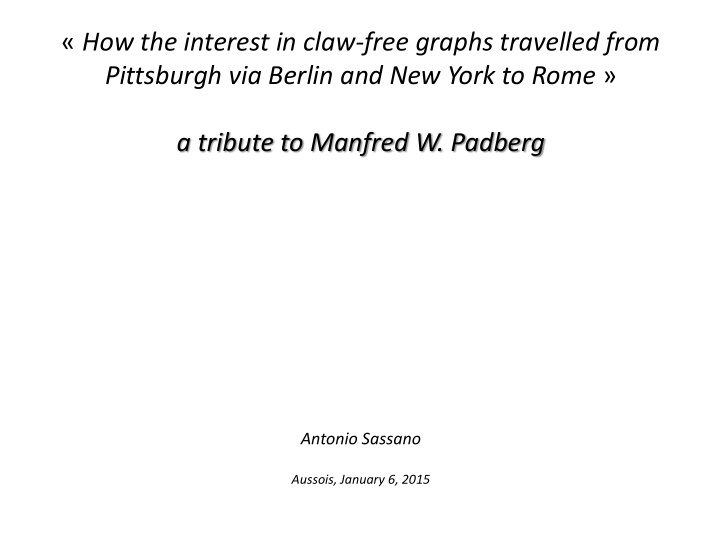



« How the interest in claw-free graphs travelled from Pittsburgh via Berlin and New York to Rome » a tribute to Manfred W. Padberg Antonio Sassano Aussois, January 6, 2015
The stable set problem has been a common thread running through all Manfred’s life « » July 2011
From the thesis with Egon Balas at GSIA (5 published papers) … Clique and «lifted» odd-cycle facets …………….
His «heart and mind» was with integer programming , applications and computations He used to say « I am interested in a problem when I can put my hands over real life instances »
What really aimed his interest to graphs and polyhedra was the goal of solving combinatorial problems « using only facet definining cutting planes » And here is his «mantra», his main contribution to my education
So .. he was interested in claw-free graphs because there was a polynomial algorithm and no ( «matching- like») separation algorithm for the Stable Set Polytope
.. And here Rome enters the picture July 2011 It was in Dublin .. at the NIHE Summer School ..
We were in the cafeteria of NIHE he took a flyer of the School, turned it over and told me: “ do you know the stable set problem ?” and, without waiting for an answer started drawing a “claw” on the back of that flyer. He told me: “ well, you know that we have and efficient algorithm to solve the matching problem based on shrinking and a beautiful characterization of the matching polyhedron. The stable set problem, on the contrary, is NP-hard but .. Claude Berge has proved that if you forbid the “claw” as induced sub-graph, you still have a good characterization of optimality in terms of augmenting paths and cycles. Moreover George Minty and Najiba Sbihi have devised polynomial algorithms to find weighted or unweighted optimal solutions. Nonetheless, nobody knows how the facet definining inequalities of stable set polyhedron for claw-free graphs look like ”
Then he paused and looked at me saying: “ I believe that the stable set problem on claw-free graphs can be solved as a matching problem. We must only find a better way to shrink subgraphs and a better way to lift them . That’s all. Our job will be that of finding new shrinkings and liftings ”. but things went differently .. (Manfred’s kind account is the following)
Indeed, I kept looking for « new shrinkings and liftings » .. and Manfred was always present. In 1984 he sent me a copy of the « reduction » algorithm devised by Lovasz and Plummer with a note saying « try to solve the weighted case! » In 1997 with Anna Galluccio we characterized all the rank (minimal) facet defining inequalities of STAB(G) for a claw-free graph. I know Manfred comment without hearing it .. « do you have a polynomial time separation routine for them? Otherwise you have half job done .. And maybe less ». In fact, this is his closing remark of the «Optima 2011» historical note:
Now something I would have liked to show him today Shrinking of Liftable clique in G H (claw-free) Lifting of (2015) (Nobili, S.) a weighting of H with the property that any MWSS S* in H saturates M and S* \ V(M) is a MWSS in G G is obtained by sequential «clique reductions» of the edges of M
(2015) (Nobili, S.) In time one can lift liftable cliques obtaining: basic claw-free graph
Which cliques do we lift? Liftable cliques Cliques we lift Articulation cliques («unglued» by Faenza et al.)
MWSS in claw-free graphs «is a» matching problem By substituting each connected component of H – M with a «gadget» ( shrinking ) as in Faenza et al. we turn the basic claw-free graph H into a line graph and compute a maximum weight matching What about the complexity? Open problem (2011) Two bottlenecks in Faenza et al.: - claw-net -free graphs - claw-free graphs with Two preliminary papers (2015) (Nobili, S.)
.. and finally As you said Manfred … it was a matter of liftings and shrinkings Thank you Maestro
Recommend
More recommend